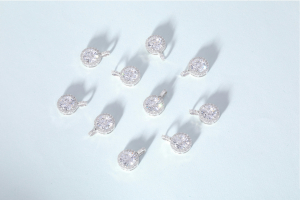USD
/
USD
/
Shipping to:
Currency:
Today, more people than ever are considering the ethical impact of their purchases, from food and clothing to high-end items like jewelry.
As consumers become more aware of global environmental and social issues, many are choosing sustainable, ethically sourced products.
When it comes to diamonds, lab-grown diamonds are emerging as an ethical and eco-friendly alternative to traditionally mined stones.
Let’s dive into why lab-grown diamonds may just be the best choice for ethical shoppers looking to make a difference with their purchases.
What Are Lab-Grown Diamonds?
Lab-grown diamonds are, quite simply, diamonds that are created in a lab rather than mined from the earth.
These diamonds are grown using advanced technology that replicates the natural diamond-growing process, resulting in stones that are physically, chemically, and optically identical to those found in nature.
Whether you’re looking at sparkle, durability, or clarity, lab-grown diamonds are virtually indistinguishable from their mined counterparts.
In recent years, lab-grown diamonds have gained popularity not only for their lower environmental impact but also for their lower cost, making them an attractive option for buyers.
For those interested in specific cuts, you can check out cushion lab-grown diamonds or explore round lab-grown diamonds.
Ethical Concerns with Mined Diamonds
Mined diamonds have a storied and often troubling past, which is why so many are seeking alternatives.
Understanding the ethical issues surrounding mined diamonds can highlight why lab-grown options are an ethical choice for today’s conscious shoppers.
Conflict Diamonds and Human Rights
The term “blood diamonds” or “conflict diamonds” emerged because many diamonds were mined and sold in conflict zones, with profits funding wars and rebel groups.
Despite efforts like the Kimberley Process to reduce conflict diamonds, the trade still has issues with transparency.
By choosing lab-grown diamonds, consumers can avoid any connection to this harmful industry, knowing that their purchase supports a conflict-free product.
Environmental Impact of Diamond Mining
Mining for diamonds has significant environmental consequences.
The process involves large-scale excavation, leading to deforestation, soil degradation, and extensive water use.
Diamond mining often leaves permanent scars on landscapes and can disrupt entire ecosystems.
Lab-grown diamonds eliminate the need for mining, resulting in a much lighter environmental footprint.
For those looking to make a sustainable statement, you might consider options like fancy-colored lab-grown diamonds, which are available in beautiful hues with minimal environmental impact.
Why Lab-Grown Diamonds Are the Ethical Choice
For those who care about the planet and human rights, lab-grown diamonds offer a responsible and ethical option.
Here’s how:
Conflict-Free Origin
Lab-grown diamonds are created in controlled laboratory settings, meaning there’s no link to conflict zones or unethical mining practices.
Each lab-grown diamond has a clear, traceable origin, giving buyers peace of mind that their purchase is truly conflict-free.
Reduced Environmental Impact
Growing diamonds in a lab eliminates the need for harmful mining practices.
Lab-grown diamonds require significantly less land, water, and energy than mined diamonds.
Many labs even incorporate renewable energy sources into their processes, further reducing their environmental impact.
Transparency and Traceability
With lab-grown diamonds, there’s no mystery about where they come from or how they were produced.
Reputable companies provide documentation and certification, allowing consumers to verify the diamond's origin and production process, ensuring complete transparency.
Sustainability Advantages of Lab-Grown Diamonds
Beyond ethical sourcing, lab-grown diamonds also present significant sustainability benefits.
For eco-conscious buyers, these gems are a win-win.
Lower Carbon Emissions and Energy Use
While producing lab-grown diamonds does require energy, innovations in technology are driving down its environmental footprint.
Some companies have adopted renewable energy in their production process, and overall, lab-grown diamonds produce fewer carbon emissions than traditional mining.
Waste Reduction and Resource Conservation
Mining generates vast amounts of waste, while lab-grown diamonds do not.
By minimizing land use and relying on controlled environments, lab-grown diamonds conserve precious resources like water and land, making them a sustainable choice.
Affordability and Accessibility of Lab-Grown Diamonds
One of the many appealing aspects of lab-grown diamonds is their affordability.
Because they are created in a controlled environment, the production costs are lower than those associated with mining.
As a result, lab-grown diamonds are typically more affordable than mined ones, offering consumers an ethical and high-quality option that fits within a wider range of budgets.
Moreover, the availability of various shapes, sizes, and settings means that there’s something for everyone in the lab-grown diamond market, regardless of style or budget.
Explore different shapes like pear-shaped lab-grown diamonds or the classic princess-cut lab-grown diamonds to find a style that matches your vision.
Lab-Grown Diamonds: A Meaningful Choice for Conscious Couples
For couples who want to make their engagement meaningful in every way, lab-grown diamonds align beautifully with their values.
Aligning with Shared Values
By choosing a lab-grown diamond, couples can symbolize their commitment not only to each other but also to ethical and sustainable choices.
These diamonds allow couples to start their journey together with a clear conscience, knowing that their decision has a positive impact on the planet and society.
Symbolizing a Responsible Choice
An engagement ring is a symbol of love and promises.
Lab-grown diamonds add another layer to that promise, representing responsibility and respect for the world around us.
This makes them a perfect fit for couples who want their ring to reflect more than just beauty.
If you’re ready to choose a unique shape that stands out, you might want to explore marquise lab-grown diamonds or even heart-shaped lab-grown diamonds.
Are Lab-Grown Diamonds Right for You?
Choosing a diamond involves more than just aesthetics, and lab-grown diamonds might be the ideal choice for those who prioritize ethics and sustainability.
Here’s a quick guide to help decide if they’re right for you.
Questions to Consider
- Do you want a diamond with a traceable, transparent origin?
- Is environmental impact an important factor in your decision?
- Are you looking for an affordable option without sacrificing quality?
Answering these questions can help you determine if a lab-grown diamond aligns with your values and goals.
Myths vs. Facts
Some people worry about the value and durability of lab-grown diamonds, but these concerns are mostly myths.
Lab-grown diamonds are just as durable as mined ones and retain their brilliance and quality over time.
As for resale value, lab-grown diamonds have made strides in the market and are increasingly being accepted by buyers and jewelers alike.
Choosing the Right Lab-Grown Diamond Retailer
Selecting a reputable retailer is crucial when buying lab-grown diamonds to ensure authenticity and ethical standards.
Research Transparency and Certifications
Look for retailers who provide certification and details about the origin and quality of their diamonds.
Certified diamonds offer assurance of authenticity and quality, giving you peace of mind about your purchase.
Look for Sustainable Practices
Some companies go above and beyond by adopting sustainable practices in production, such as using renewable energy.
Take the time to find retailers who prioritize environmental responsibility in addition to ethical sourcing.
Frequently Asked Questions (FAQs)
Are lab-grown diamonds real diamonds?
Yes, lab-grown diamonds are real diamonds.
They have the same physical, chemical, and optical properties as mined diamonds, making them virtually identical.
Do lab-grown diamonds cost less than mined diamonds?
Typically, lab-grown diamonds are more affordable than mined diamonds due to the controlled production process, which does not involve the costs associated with mining.
Are lab-grown diamonds sustainable?
Lab-grown diamonds are considered a more sustainable option than mined diamonds.
They require less land, water, and energy and avoid the environmental harm associated with mining.
Can you tell the difference between lab-grown and mined diamonds?
To the naked eye, lab-grown and mined diamonds are indistinguishable.
Only specialized equipment can detect the difference.
Do lab-grown diamonds have resale value?
While the resale market for lab-grown diamonds is still developing, they are becoming more accepted by jewelers and buyers as awareness grows.
However, as with all diamonds, resale value can vary.
Is it possible to find unique settings for lab-grown diamonds?
Absolutely!
Lab-grown diamonds come in all the same shapes, sizes, and settings as mined diamonds, allowing you to find or create a unique piece that suits your personal style.







